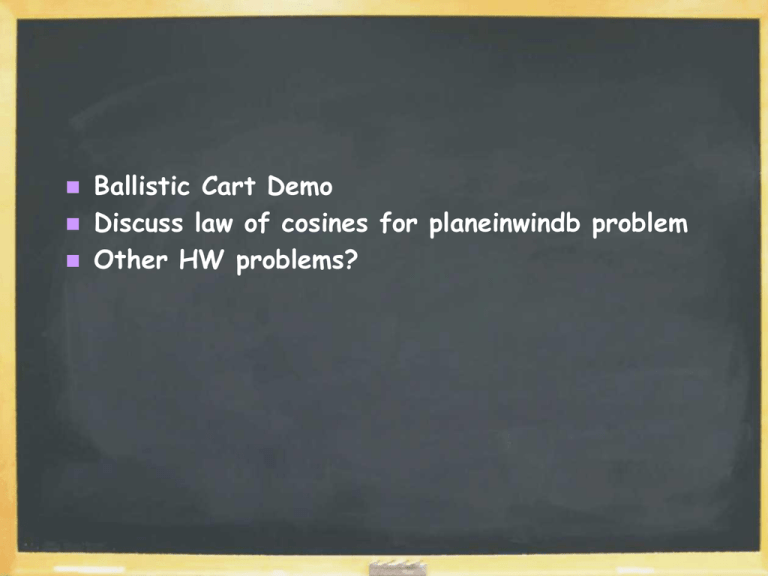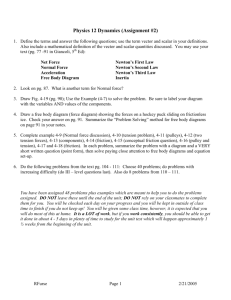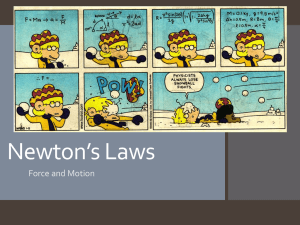Ballistic Cart Demo Discuss law of cosines for planeinwindb problem
advertisement

Ballistic Cart Demo Discuss law of cosines for planeinwindb problem Other HW problems? Chapter 4 Forces and Mass Classical Mechanics does not apply for very tiny objects (< atomic sizes) objects moving near the speed of light Newton’s First Law If the net force SF exerted on an object is zero the object continues in its original state of motion. That is, if SF = 0, an object at rest remains at rest and an object moving with some velocity continues with the same velocity. Contrast with Aristotle! Forces Usually a push or pull Vector Either contact or field force Contact and Field Forces Fundamental (Field) Forces Types Strong nuclear force Electromagnetic force Weak nuclear force Gravity Strong Nuclear Force QCD (Quantum chromodynamics) confines quarks by exchaning gluons Nuclear force: binds protons and neutrons by exchanging pions Electromagnetic Forces Opposites attract, like-signs repel Electric forces bind electrons in atoms Magnetic forces arise from moving charges Weak Nuclear Force Involves exchange of heavy W or Z particle Responsible for decay of neutrons Gravity Attractive force between any two bodies Proportional to both masses Inversely proportional to square of distance F G m1 m2 r 2 Inertia (Newton’s First Law) Tendency of an object to continue in its original motion Mass A measure of the resistance of an object to changes in its motion due to a force Scalar SI units are kg Newton’s Second Law Acceleration is proportional to net force and inversely proportional to mass. F ma Units of Force SI unit is Newton (N) F ma kg m 1N 1 2 s US Customary unit is pound (lb) 1 N = 0.225 lb Weight Weight is magnitude of gravitational force mass weight w mg M earth m wG 2 r GM earth g 2 Rearth Weight vs. Mass Mass is an inherent property Weight depends on location Newton’s Third Law F12 F21 Force on “1” due to “2” Single isolated force cannot exist For every action there is an equal and opposite reaction Newton’s Third Law cont. F12 is action force F21 is reaction force You can switch action <-> reaction Action & reaction forces act on different objects Action-Reaction Pairs n n ' Fg Fg Define the OBJECT (free body) Newton’s Law uses the forces acting ON object n and Fg act on object n’ and Fg’ act on other objects Assumptions for F=ma Objects behave as particles ignore rotational motion (for now) Consider only forces acting ON object neglect reaction forces Problem Solving Strategy Identify object (free body) Label all forces acting on object Resolve forces into x- and y-components, using convenient coordinate system Apply equations, keep track of signs! Mechanical Forces Strings, ropes and Pulleys Gravity Normal forces Friction Springs (later in the book) Some Rules for Ropes and Pulleys Force from rope points AWAY from object Magnitude of the force is called tension Tension does not change when going over a pulley (if frictionless) Equilibrium F 0 Cable Pull Demo Example 4.1 Given that Mlight = 25 kg, find all three tensions T3 = 245.3 N, T1 = 147.4 N, T2 = 195.7 N Example 4.2 2) Which statements are correct? Assume the objects are static. A) B) C) D) T1 must = T2 T2 must = T3 T1 must be < Mg T1+T2 must be > Mg A) T B) T C) T D) T cos(10o)=0.985 sin(10o)=0.173 Example 4.3 a) Find acceleration b) Find T, the tension above the bowling ball c) Find T3, the tension in the rope between the pails d) Find force ceiling must exert on pulley a) a = g/6 = 1.635 m/s2 b) T = 57.2 N c) T3=24.5 N d) Fpulley=2T = 114.5 N Inclined Planes Choose x along the incline and y perpendicular to incline Replace force of gravity with its components Fg , x mg sin Fg , y mg cos Example 4.4 Find the acceleration and the tension a = 4.43 m/s2, T= 53.7 N Example 4.5 M Find M such that the box slides at constant v M=15.6 kg Forces of Friction Resistive force between object and neighbors or the medium Examples: Sliding a box Air resistance Rolling resistance Sliding Friction f s N f k N s k Direction parallel to surface, opposite to other forces Nearly independent of the area of contact The coefficient of friction (µ) depends on the surfaces in contact Coefficients of Friction f s N f k N s k Static Friction, ƒs If F s n, f s F s is coefficient of static friction n is the normal force f F Kinetic Friction, ƒk If F s n, f k n k is coefficient of kinetic friction Friction force opposes F n is the normal force f F Friction Demo Example 4.6 The man pushes/pulls with a force of 200 N. The child and sled combo has a mass of 30 kg and the coefficient of kinetic friction is 0.15. For each case: What is the frictional force opposing his efforts? What is the acceleration of the child? f=59 N, a=3.80 m/s2 / f=29.1 N, a=4.8 m/s2 Example 4.7 Given m1 = 10 kg and m2 = 5 kg: a) What value of s would stop the block from sliding? b) If the box is sliding and k = 0.2, what is the acceleration? c) What is the tension of the rope? a) s = 0.5 b) a=1.96 m/s2 c) 39.25 N Example 4.8 What is the minimum s required to prevent a sled from slipping down a hill of slope 30 degrees? s = 0.577 Other kinds of friction Air resistance, F ~ Area v2 Rolling resistance, F ~ v Terminal velocity: Fresistance CAv mg at termina l velocity 2 Coffee Filter Demo Accelerating Reference Frames Equivalent to “Fictitious” gravitational force g fictitious a frame Fictitious Force: Derivation 1 2 x v0t at 2 1 F 2 Eq. of motion in fixed frame v0t t 2m 1 2 x0 (t ) a f t 2 1 ( F ma f ) 2 x x0 (t ) v0t t 2 m F-maf looks like force in new frame, maf acts like fake gravitational force! Example 4.9 An elevator falls with acceleration a = 8.0 m/s2. If a 200-lb person stood on a bathroom scale during the fall, what would the scale read? 36.9 lbs Example 4.10 You are calibrating an accelerometer so that you can measure the steady horizontal acceleration of a car by measuring the angle a ball swings backwards. If M = 2.5 kg and the acceleration, a = 3.0 m/s2: a) At what angle does the ball swing backwards? b) What is the tension in the string? = 17 deg T= 25.6 N

